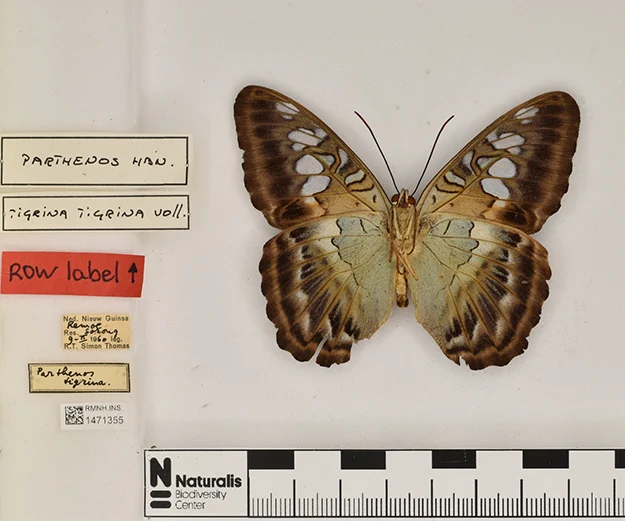BLOG - Two 7 cm wide, dried imago butterflies are the oldest preserved specimens of animal in the history of science. The exceptionally well-preserved specimens were collected in Sorong, Papua (-0.883333, 131.255828) in 1630, making them the earliest type of collection in the history of modern animal taxonomy.
The two butterflies, stored at the Naturalis Biodiversity Center in Leiden with ID: RMNH.INS.1471355, have different colors. The first butterfly has a dark brown body with dark brown and white wings, while the second specimen has a light brown body with light brown and white wings.
There is no information about who first collected the specimens from the wild and there was no formal taxon description until Samuel Constant Snellen van Vollenhoven (1816-1880) described them both as Parthenos tigrina in 1866.
Vollenhoven was born in Rotterdam and was an entomologist and curator at the Naturalis Biodiversity Center from 1854 to 1873, retiring due to health problems. He founded Tijdschrift voor Entomologie in 1857, a journal of systematic and evolutionary entomology published by the Netherlands Entomological Society.
He described 9 genera and 471 species of insects. Together with Frederik Maurits van der Wulp (1818-1899), they compiled the first checklist of Diptera in the Netherlands. Wulp was an etymologist born in The Hague whose main interest was in Diptera.
Interestingly, the genus Parthenos first appeared from Jacob Hübner (1761-1826) in 1819, which had the synonyms Minetra Boisduval (1832) and Parthenus Agassiz (1846). Hübner was an Augsburg-born entomologist, one of the earliest figures in the field of entomological research and completed his first work entitled Beiträge zur Geschichte der Schmetterlinge in 1786-1790.
Over time two new species appeared in this genus, Parthenos cyaneus Moore (1877) and Parthenos aspila Honrath (1888). In 1904 the subspecies Parthenos tigrina subsp. pardalis Fruhstorfer appeared and thus the specimen RMNH.INS.1471355 changed to Parthenos tigrina subsp. tigrina van Vollenhoven (1866).
In 1912 Parthenos tigrina subsp. terentianus Fruhstorfer appeared and in 1915 Parthenos tigrina subsp. mysolica Rothschild appeared. Parthenos is family: Nymphalidae, order: Lepidoptera, class: Insecta, phylum: Arthropoda and kingdom: Animalia.
Read more:
Specimen RMNH.INS.1471355, Naturalis Biodiversity Center, https://data.biodiversitydata.nl/naturalis/specimen/RMNH.INS.1471355 (August 18, 2024)
By Aryo Bandoro
Founder of Dlium.com. You can follow him on X: @Abandoro.
The two butterflies, stored at the Naturalis Biodiversity Center in Leiden with ID: RMNH.INS.1471355, have different colors. The first butterfly has a dark brown body with dark brown and white wings, while the second specimen has a light brown body with light brown and white wings.
There is no information about who first collected the specimens from the wild and there was no formal taxon description until Samuel Constant Snellen van Vollenhoven (1816-1880) described them both as Parthenos tigrina in 1866.
Vollenhoven was born in Rotterdam and was an entomologist and curator at the Naturalis Biodiversity Center from 1854 to 1873, retiring due to health problems. He founded Tijdschrift voor Entomologie in 1857, a journal of systematic and evolutionary entomology published by the Netherlands Entomological Society.
He described 9 genera and 471 species of insects. Together with Frederik Maurits van der Wulp (1818-1899), they compiled the first checklist of Diptera in the Netherlands. Wulp was an etymologist born in The Hague whose main interest was in Diptera.
Interestingly, the genus Parthenos first appeared from Jacob Hübner (1761-1826) in 1819, which had the synonyms Minetra Boisduval (1832) and Parthenus Agassiz (1846). Hübner was an Augsburg-born entomologist, one of the earliest figures in the field of entomological research and completed his first work entitled Beiträge zur Geschichte der Schmetterlinge in 1786-1790.
Over time two new species appeared in this genus, Parthenos cyaneus Moore (1877) and Parthenos aspila Honrath (1888). In 1904 the subspecies Parthenos tigrina subsp. pardalis Fruhstorfer appeared and thus the specimen RMNH.INS.1471355 changed to Parthenos tigrina subsp. tigrina van Vollenhoven (1866).
In 1912 Parthenos tigrina subsp. terentianus Fruhstorfer appeared and in 1915 Parthenos tigrina subsp. mysolica Rothschild appeared. Parthenos is family: Nymphalidae, order: Lepidoptera, class: Insecta, phylum: Arthropoda and kingdom: Animalia.
Read more:
Specimen RMNH.INS.1471355, Naturalis Biodiversity Center, https://data.biodiversitydata.nl/naturalis/specimen/RMNH.INS.1471355 (August 18, 2024)
By Aryo Bandoro
Founder of Dlium.com. You can follow him on X: @Abandoro.

